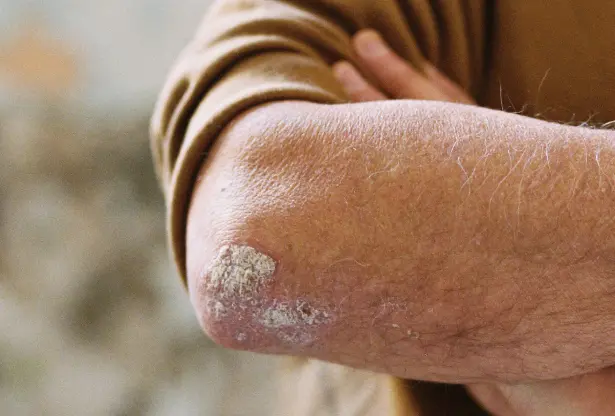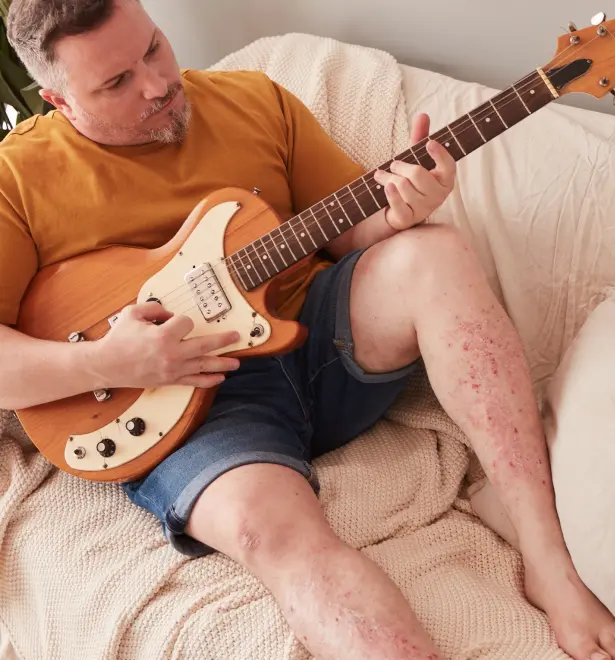About Psoriasis
Everything you should know
Psoriasis is a chronic inflammatory disease that involves the skin and nails, and it is associated with a number of comorbidities, that profoundly impacts wellbeing.
The inflammation manifests in the skin, as localized or generalized patches. These patches can be red, (on Caucasian skin) or dark (on darker skin tones) flaky, itchy and scaly.
Chronic psoriasis is a lifelong illness. The periods when the plaques occur are called flareups , and the periods when they disappear are called remissions. The disappearance of patches does not necessarily mean that the psoriasis is cured, since this resolution is only temporary. Flareups and remissions are part of the normal clinical course of psoriasis.
In addition, people with psoriasis are more likely to suffer from other chronic diseases , such as diabetes and cardiovascular disease, so early detection and proper treatment of these diseases by a doctor is of the utmost importance to prevent their progression.
Psoriasis is universal in occurrence. Psoriasis can begin at any age but it is uncommon before the age of 10 years. It is most likely to appear between the ages of 15 and 30 years. Psoriasis appears to be equally common in males and females.

An estimated 60 million people worldwide have psoriasis 4 .


The exact cause of psoriasis is unknown but, about 30% of those affected by the condition, have direct relatives with psoriasis, so there is evidence of a genetic predisposition. However, inheriting psoriatic genes does not necessarily result in developing psoriasis, and other factors are necessary to develop the disease. other factors are necessary to develop the disease.
The etiology of psoriasis remains unclear, although there is evidence of a genetic predisposition. Heredity does not fully explain why psoriasis occurs. Other factors, such as health and lifestyle habits, may increase the probability of developing psoriasis, especially in individuals with a genetic predisposition 5 .
- Infections. Infections can trigger and exacerbate psoriasis.
- Stress. Stress is associated with both the onset of psoriasis and flareups in people previously diagnosed with psoriasis.
- Weather. Skin psoriasis usually gets worse in the winter and improves during summer.
- Tobacco. The risk of the onset of psoriasis in smokers is twice that of non_smokers. In addition, it seems that the greater amount and the longer you smoke, the higher the risk.
- Alcohol. As with smoking, alcohol use also seems to play a role in the onset of psoriasis. Furthermore, alcohol increases its severity and may decrease treatment efficacy.
- Obesity. It has been shown to be an independent risk factor for psoriasis.
- Other skin lesions. Any alteration of the skin―such as scratches, piercings or sunburns―can cause psoriasis lesions to appear. This is Koebner's phenomenon.

Did you know that psoriasis can manifest itself in different ways?
Plaque psoriasis, also known as psoriasis vulgaris, is the most common type of psoriasis, affecting almost 9 out of every 10 people with this skin disease 6 .
It is characterized by red patches covered with white or silver flaky scales. These plaques are of different sizes and can be found in certain zones of the body , or cover most of the skin. They usually appear on elbows, knees, the scalp, and the lower back. However, they can also appear anywhere on the skin.
Although plaque psoriasis is the most common, it is not the only kind.
Psoriasis can appear as red patches and also as drops, blisters or as a general reddening of the skin. Depending on its form and location, it will be a different type of psoriasis:

| Type of psoriasis | Main characteristic | Characterization | Manifestation |
|---|---|---|---|
| Plaque psoriasis | The most common. 90% of people with psoriasis have this type. | Red patches covered with white or silver flaky scales. Their size varies from small patches to large plaques that can cover a large area of the body. They are often itchy and painful, and they can crack and bleed. | Usually on the elbows, knees, scalp, and lower back. |
| Guttate psoriasis | The second most common. The most frequent form among children or adolescents. | Reddish colour and may be covered by flaky layers of skin. | Usually on the torso and at the top of the arms and legs. |
| Inverse psoriasis | Relatively rare, accounting for 2% to 6% of all cases of psoriasis. | Very red plaques around skin folds. Cracks may appear at the edges. | Usually in parts such as behind the knee, under the arm, in the groin, and in other skin folds around the genitals and buttocks. |
| Pustular psoriasis | Rare type of psoriasis. Mainly affects adults. | Pustules. The pustules can group together in a cluster and form a single, larger blister. | Usually affects feet and hands. |
| Erythrodermic psoriasis | The most severe form of psoriasis, but the least frequent. | Red rash and scaling. | Affects nearly all the skin. |
The
symptoms of psoriasis
depend, most importantly
on the type and location.
Plaque psoriasis is the most common type of psoriasis with the following signs & symptoms:
.webp)
|
Rounded red or oval spots lined with white or silver scales Their size is variable, ranging from small patches to large plaques that can cover a large area of the body. The most typical locations are the elbows, knees, lower back area and scalp but they can also appear in any area of the skin. |
.webp)
|
Itching Itching is one of the most frequent symptoms of psoriasis patients, and it may have a greater impact on quality of life than the visible effects of the disease. Prevalence of itching affects 60-90% 7 of patients, acting as a primary source of discomfort and affecting physical and mental wellbeing. |

|
Burning, pain or bleeding Likewise, skin pain has been reported by up to 90% of patients. Another typical sign of psoriasis is Koebner's phenomenon. With this condition, any skin trauma (scratches, burns, etc.) causes psoriasis lesions to appear 2 to 6 weeks after trauma to the skin. This happens to 1 in 4 people with psoriasis. |
What should I do if I observe any symptoms?
As we have seen, psoriasis can manifest in far more places than just the skin. Everyday life with psoriasis can be challenging.
There may be times when you are feeling healthy, strong and resilient but there may also be times when you experience feelings like loneliness, embarrassment, anxiety, low self-esteem, depression, anger or fear.
Working with your healthcare provider to find a treatment plan that helps effectively manage your psoriatic disease can lessen your daily discomfort and create a sense of hope for the future. It is equally important to acknowledge how psoriatic disease impacts your life, ask for help from those around you, and create healthy habits to manage the challenges of living with a chronic disease.

The impact of psoriasis goes beyond the obvious severity of skin lesions. It disrupts every aspect of patients' everyday lives, causing great physical, emotional and social burdens and affecting their mental health.
88% of people 8 with psoriasis experience disruptions in every aspect of their everyday lives.
Sleep disruption:
Sleep disturbance in patients with psoriasis is highly prevalent. In fact, 61% of patients with pruritus suffer from it 9 .
Sleep disruption is associated with a lower quality of life and a higher risk of metabolic and psychological disorders, which can then impact work, family and social life.
Difficulty in social relationships and the workplace:
Social exclusion, discrimination and stigma have a high impact on the person suffering from psoriasis and their families. Physically, fatigue and absence from work may also limit productivity and the ability to perform tasks.
Impact of psoriasis on self-esteem and mood:
Psoriasis can cause insecurity and low self-esteem. You may feel more self-conscious and worry about other people's reactions and what they think of you. The symptoms of psoriasis reduce wellbeing and cause concern for personal appearance, shame, guilt, poor self-esteem, embarrassment, isolation and work difficulties.
As a result, 1/4 of people show signs of depression and 48% have anxiety disorders 10 .

Impact of psoriasis in difficult to treat areas:
Although psoriasis usually appears on the shoulders, knees and lower back, it can affect other areas in which can be particularly burdensome:

|
Scalp psoriasis: This represents an important psychosocial handicap; in fact, 31% of patients with scalp psoriasis indicated distress 11 . The most annoying symptoms were:
|

|
Skin Folds: Inverse psoriasis can occur in skin folds such as the armpits and under the breasts. They are red, smooth and bright spots that appear in the groins, genitals, armpits, intergluteal cleft between the buttocks, and under the breasts in women. Due to the humidity of these areas, the spots have no flaky layers. It can coexist with other types of psoriasis in the same person. |

|
Genital psoriasis: Around 80% of patients with genital psoriasis report that their sexual life is affected 12 . This may be associated with:
|

|
Palms and soles of the feet: Psoriasis in these areas can have a very negative impact on quality of life. It is often accompanied by painful cracks and fissures that may bleed. |

|
Nails: Nail psoriasis affects up to half of all people with psoriasis. Nail pinprick holes are typical, as if the nails had been punctured with a pin. These points make that part of the nail look like a thimble. It is also typical for the nail to turn white and the end to peel off and turn grey with a yellowish rim. Sometimes the nail gets very thick. |

|
Face: Facial psoriasis is rare but, because it is so visible, the psychological impact can be significant. It typically occurs on the eyebrows, the skin between the nose and upper lip, the upper forehead and the hairline. Psoriasis on and around the face should be treated carefully as the skin here is very sensitive. |
Psoriasis is a chronic disease that usually requires lifelong treatment. As the cause of psoriasis is still unknown, the treatment available is only for controlling signs and symptoms of the disease.
There are different treatment options for psoriasis, such as topical treatments (applied externally to the skin), phototherapy (with UV light) or systemic medications.
Patients with psoriasis face numerous treatment and self-management decisions.
Shared decision-making is a novel approach, where patients' preferences and values are considered in cooperation with healthcare professionals before making treatment decisions.





